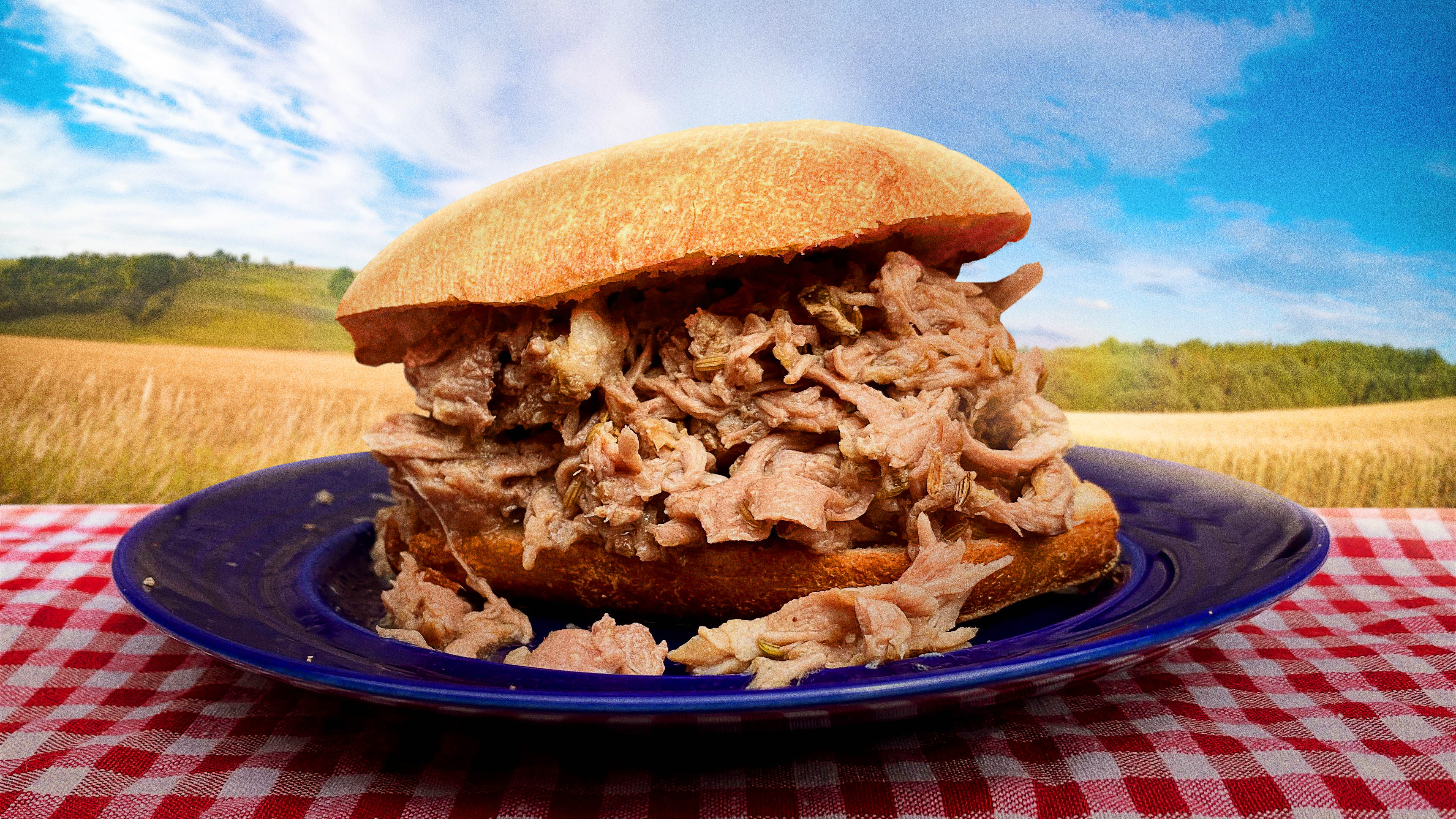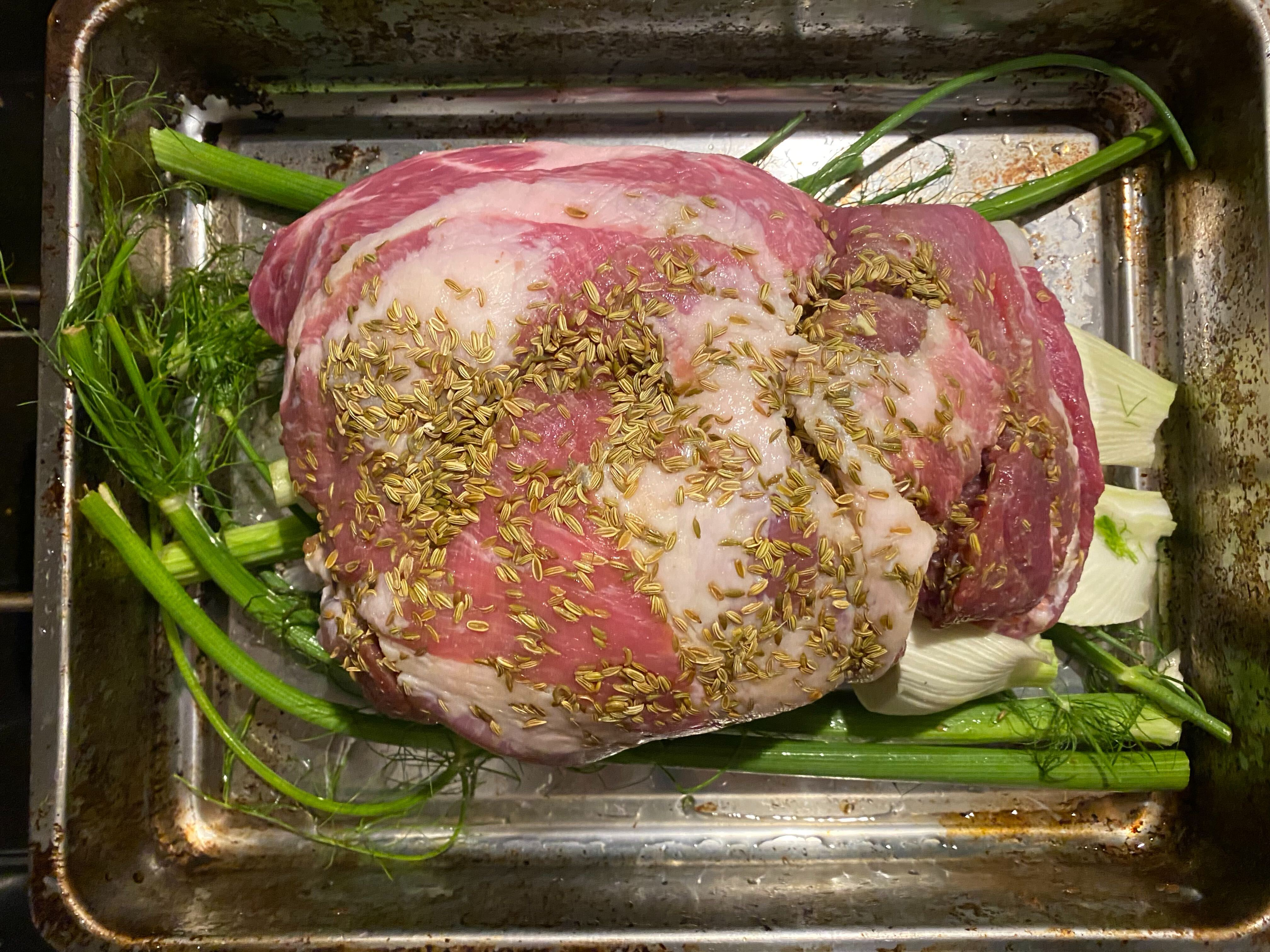These Iron Range Porketta Sandwiches Are Minnesota Nice
Today, I give you yet another recipe I discovered in the collection of church cookbooks, index cards, and crumpled-up pieces of scrap paper I inherited from my late grandmother-in-law, who was born and raised in a small town in Iowa. I, born and raised in Brooklyn, know very little about the foods of the Midwest; I do know porchetta, but had never even heard of the Iron Range. As two of my greatest passions are learning new things and eating new sandwiches, I knew I had to make this, and once I'd tasted it, I knew you needed to make it, too.
The Iron Range is what us Yankees call "up near the top part of Minnesota that sticks out a bit." In the 19th century, Minnesotans discovered just how rich the area was in iron ore deposits and tried to mine it before their entire operation was crushed by John D. Rockefeller, Henry Oliver, and Andrew Carnegie, who formed an alliance that would grow into the world's very first billion-dollar corporation: U.S. Steel.
Oliver's mining company needed people to work in dangerous conditions for very little pay, and so they exploited "recruited" immigrants for the job. At the time, most immigrants in Minnesota were from Scandinavia, where organized labor was already a popular concept. In 1907, the dock workers who shipped the iron ore demanded safer working conditions, a minimum wage, and an eight-hour workday. Immediately, 200 workers were fired, and the following day, more than 10,000 miners went on strike. The company responded by hiring strikebreakers, blacklisting Scandinavians, and replacing workers with the new wave of poor immigrants coming in from Italy. Though the workers ultimately lost the strike two months later, the new wave of Italian immigrants had introduced porchetta sandwiches to Northern Minnesota, and that's the smallest but most delicious silver lining that could have arisen from the situation.
It took about 80 years to nearly deplete the 2-billion-year-old range of iron ore, but nothing could deplete Minnesota's love of pork sandwiches. Over time, Italian porchetta, which is made of pork belly and loin, became American porketta, a humble pork shoulder marinated with garlic powder and fennel seeds, slow roasted until it becomes melt-in-your-mouth tender, shredded into fat chunks, and piled high on a crusty roll. It's a tasty testament to the workers who sacrificed so much in hopes that future generations could have a better life. They've given us way more than sandwiches to be thankful for.

Iron Range Porketta Sandwiches
- 1 boneless pork shoulder, about 6 lbs.
- 1/4 cup fennel seeds
- 1 Tbsp. garlic powder
- 1 Tbsp. kosher salt
- 2 tsp. freshly cracked black pepper
- 1 large bulb fennel
- 1 head garlic, peeled
- 1 large onion, peeled and cut into thick rings
- Crusty sandwich rolls
Gently crush the fennel seeds with the back of a heavy skillet. Toss them into the skillet, place over high heat, and toast for about 2 minutes until fragrant. Add to a small bowl and mix with the garlic powder, kosher salt, and black pepper.
Slice the pork open like a book, then cut 1/2-inch-deep slits about 2 inches apart in a crosshatch pattern. Rub all over with the spice mixture, making sure it gets into all the slits, then roll up tightly and wrap in plastic wrap. Let the pork marinate in the refrigerator for at least six hours, up to 24.
Preheat the oven to 325 degrees Fahrenheit. Remove the fennel bulb's feathery fronds; save for another use. Cut the stems, separate the bulb into large pieces, and throw it all into a roasting pan with the garlic and onion. Put the pork roast on top of the vegetables, then wrap the pan tightly with aluminum foil. Slide into the oven and roast until a thermometer inserted into the center of the pork registers 200 degrees Fahrenheit (about 3-4 hours).
Remove the foil and let the porketta rest for at least 30 minutes, then move to a cutting board and roughly shred. Pour the vegetables and juices in the pan through a fine mesh strainer; discard the solids, skim any fat that rises to the top, then add back to the pan along with the shredded pork and toss well. Taste for seasoning, adding a bit of salt and pepper as desired, then serve warm or room temperature on crusty rolls.
Note: This recipe makes more than enough pork for a crowd, something none of us will be part of any time soon. Eat as much as you want, then freeze the rest in airtight containers for up to eight months.

